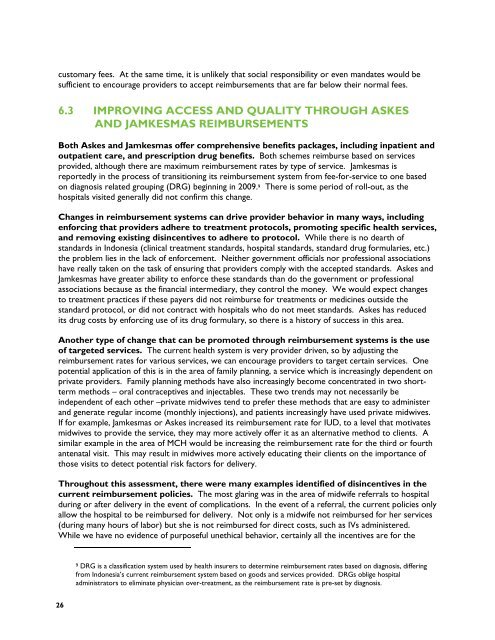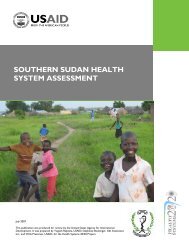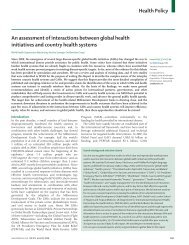PRIVATE SECTOR HEALTH CARE IN INDONESIA - Health Systems ...
PRIVATE SECTOR HEALTH CARE IN INDONESIA - Health Systems ...
PRIVATE SECTOR HEALTH CARE IN INDONESIA - Health Systems ...
- No tags were found...
You also want an ePaper? Increase the reach of your titles
YUMPU automatically turns print PDFs into web optimized ePapers that Google loves.
customary fees. At the same time, it is unlikely that social responsibility or even mandates would besufficient to encourage providers to accept reimbursements that are far below their normal fees.6.3 IMPROV<strong>IN</strong>G ACCESS AND QUALITY THROUGH ASKESAND JAMKESMAS REIMBURSEMENTSBoth Askes and Jamkesmas offer comprehensive benefits packages, including inpatient andoutpatient care, and prescription drug benefits. Both schemes reimburse based on servicesprovided, although there are maximum reimbursement rates by type of service. Jamkesmas isreportedly in the process of transitioning its reimbursement system from fee-for-service to one basedon diagnosis related grouping (DRG) beginning in 2009. 9 There is some period of roll-out, as thehospitals visited generally did not confirm this change.Changes in reimbursement systems can drive provider behavior in many ways, includingenforcing that providers adhere to treatment protocols, promoting specific health services,and removing existing disincentives to adhere to protocol. While there is no dearth ofstandards in Indonesia (clinical treatment standards, hospital standards, standard drug formularies, etc.)the problem lies in the lack of enforcement. Neither government officials nor professional associationshave really taken on the task of ensuring that providers comply with the accepted standards. Askes andJamkesmas have greater ability to enforce these standards than do the government or professionalassociations because as the financial intermediary, they control the money. We would expect changesto treatment practices if these payers did not reimburse for treatments or medicines outside thestandard protocol, or did not contract with hospitals who do not meet standards. Askes has reducedits drug costs by enforcing use of its drug formulary, so there is a history of success in this area.Another type of change that can be promoted through reimbursement systems is the useof targeted services. The current health system is very provider driven, so by adjusting thereimbursement rates for various services, we can encourage providers to target certain services. Onepotential application of this is in the area of family planning, a service which is increasingly dependent onprivate providers. Family planning methods have also increasingly become concentrated in two shorttermmethods – oral contraceptives and injectables. These two trends may not necessarily beindependent of each other –private midwives tend to prefer these methods that are easy to administerand generate regular income (monthly injections), and patients increasingly have used private midwives.If for example, Jamkesmas or Askes increased its reimbursement rate for IUD, to a level that motivatesmidwives to provide the service, they may more actively offer it as an alternative method to clients. Asimilar example in the area of MCH would be increasing the reimbursement rate for the third or fourthantenatal visit. This may result in midwives more actively educating their clients on the importance ofthose visits to detect potential risk factors for delivery.Throughout this assessment, there were many examples identified of disincentives in thecurrent reimbursement policies. The most glaring was in the area of midwife referrals to hospitalduring or after delivery in the event of complications. In the event of a referral, the current policies onlyallow the hospital to be reimbursed for delivery. Not only is a midwife not reimbursed for her services(during many hours of labor) but she is not reimbursed for direct costs, such as IVs administered.While we have no evidence of purposeful unethical behavior, certainly all the incentives are for the9 DRG is a classification system used by health insurers to determine reimbursement rates based on diagnosis, differingfrom Indonesia’s current reimbursement system based on goods and services provided. DRGs oblige hospitaladministrators to eliminate physician over-treatment, as the reimbursement rate is pre-set by diagnosis.26
















